Current care
In the process of car maintenance, you will soon be convinced that it is possible - and necessary - to combine many procedures due to the similarity of actions for their implementation. For example, if the vehicle is raised off the ground to lubricate the chassis, you should simultaneously inspect the exhaust system, suspension, steering system, and fuel system while you are under the vehicle. If the wheels are removed for other work, it makes sense to check the brakes. Finally, suppose you had to borrow or rent a torque wrench. Even if you only need it to tighten the spark plugs, you can also check the tightening torques of as many critical nuts and bolts as you have time.
The first step in a car maintenance program is self-preparation. Carefully study the materials of all Sections related to the upcoming procedures, then prepare all the necessary materials, equipment and tools. If you are afraid of encountering problems when performing any specific work, consult a specialist or a person who has already carried out this work.
Warning: Service stations additionally, at each service, use a fault memory interrogator to read data from the fault memory of the electronic control units of the engine, ABS, airbag and anti-theft system. For this purpose, it is recommended to contact the service station at certain intervals. At the same time, it must be borne in mind that some malfunctions, for example, failed sensors of the engine management system, do not lead to a noticeable decrease in vehicle performance. The control units have an emergency operation mode or operate on averaged parameter values stored in the memory, which cannot be detected by the driver. Interrogation of the fault memory is carried out through the diagnostic connector. Service is carried out in accordance with a certain period and mileage of the car.
Engine compartment hood
There is a risk of injury when the hood is open and the engine is running.
After the engine is turned off, the radiator fan blades may rotate for approximately 30 seconds.
The engine is equipped with an electronic ignition system. Due to the high voltage of the ignition system, it is very dangerous to touch the elements of the ignition system (ignition coil, ignition distributor, high voltage wire, spark plug tips, test connector):
- With the engine running,
- When starting the engine,
- When the ignition key is in position 2 and the engine crankshaft is turned by hand.
Bonnet release
The hood release handle is located inside the vehicle.
1. Pull the handle located under the instrument panel in the direction of the arrow. In this case, the hood will be pushed out of the constipation by the force of the spring. At the same time, the unlocking tongue extends outward through the radiator grille.
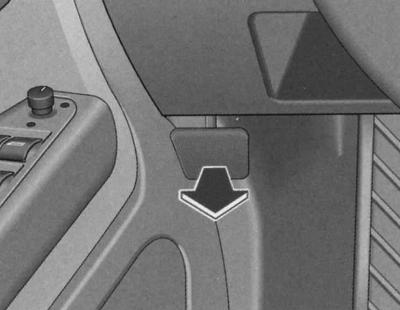
Hood opening
Before opening the hood, make sure that the wiper blades are on the windshield. Otherwise, they may damage the paintwork.
1. Raise the hood slightly.
2. Pull the release tab in the direction of the arrow. In this case, the hood will be released from the catch-hook holding it.
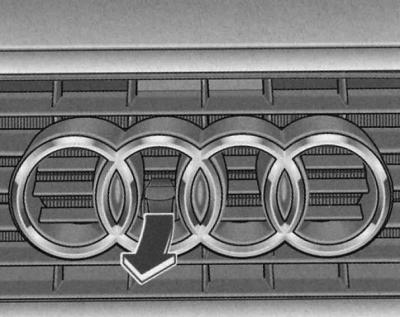
3. Open the hood. The open hood is held in the upper position by a gas-filled stop.
Carrying out work in the engine compartment
When carrying out any kind of work in the engine compartment, special care is required! Views under the hood are shown on ref. illustrations.
View under the hood of a 4-cylinder gasoline engine
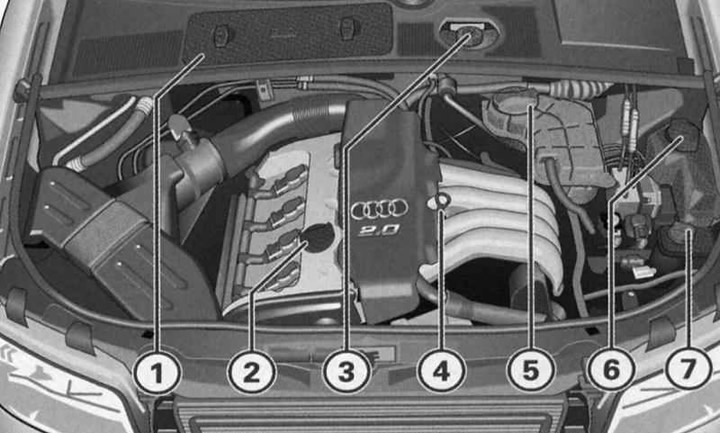
- 1 - Battery (under cover)
- 2 - Oil filling hole of the engine
- 3 - Brake fluid reservoir
- 4 - Engine oil dipstick (orange)
- 5 - Expansion tank of the cooling system
- 6 — the Refueling reservoir of a windshield washer
- 7 - Power steering fluid reservoir (green lid)
View under the hood of a 6-cylinder gasoline engine
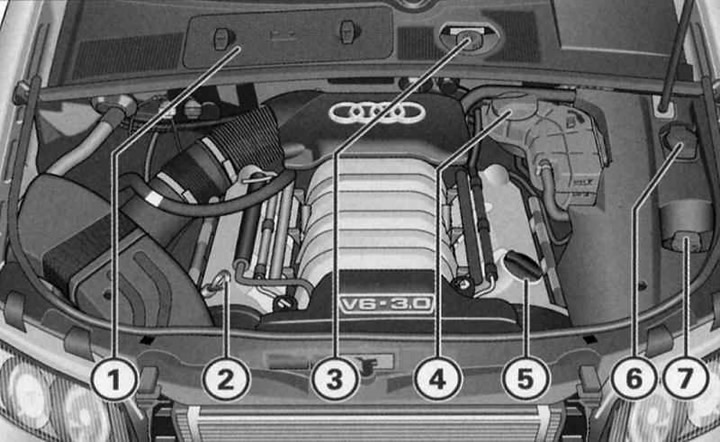
- 1 - Battery (under cover)
- 2 - Oil filling hole of the engine
- 3 - Brake fluid reservoir
- 4 - Engine oil dipstick (orange)
- 5 - Expansion tank of the cooling system
- 6 — the Refueling reservoir of a windshield washer
- 7 - Power steering fluid reservoir (green lid)
View under the hood of a 4-cylinder diesel engine
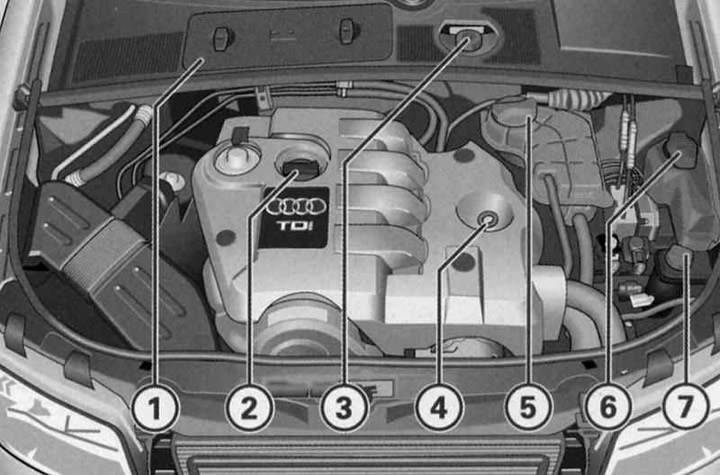
- 1 - Battery (under cover)
- 2 - Oil filling hole of the engine
- 3 - Brake fluid reservoir
- 4 - Engine oil dipstick (orange)
- 5 - Expansion tank of the cooling system
- 6 — the Refueling reservoir of a windshield washer
- 7 - Power steering fluid reservoir (green lid)
View under the hood of a 6-cylinder diesel engine
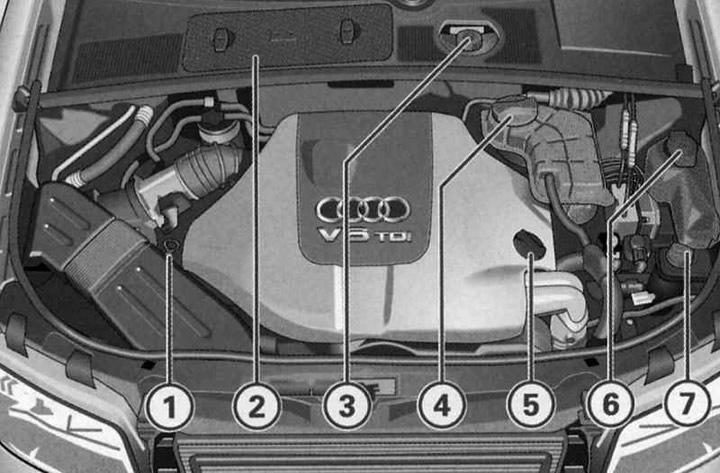
- 1 - Battery (under cover)
- 2 - Oil filling hole of the engine
- 3 - Brake fluid reservoir
- 4 - Engine oil dipstick (orange)
- 5 - Expansion tank of the cooling system
- 6 — the Refueling reservoir of a windshield washer
- 7 - Power steering fluid reservoir (green lid)
Warning: In order to avoid serious malfunctions, be careful not to mix up the operating fluids when topping up different systems with them!
Warning: Regular inspection of the underbody of the car contributes to the timely detection of leaks. If there are stains of oil or other operating fluids, have the car checked by a workshop.
Closing the hood
1. Pull the hood down until the force of the gas spring is fully overcome.
2. Slam the hood with a light blow so that it snaps into place; don't click extra!

Visitor comments